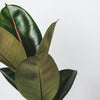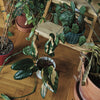Monstera will bring a piece of the jungle to your home

Monstera is one of the most popular houseplants across generations. They reached their peak of popularity especially during the period of socialism, when you could see them in every hotel, restaurant and waiting room, and they were often very large pieces reaching up to several meters. After that, however, interest in these plants declined. They have come to prominence only now in recent years with the great interest of people in houseplants in general and especially with the influx of variegated species, which until recently were practically impossible to purchase.
The very name "monstera" suggests that this is no scumbag. The best known and most widespread species Monstera deliciosa known for its huge carved and perforated leaves can reach up to several meters and its leaves can be over 1 meter in size, perhaps that is why it earned the nickname " queen of maids ". It should therefore be noted that if you want to have this plant at home, you will have to give it enough space.
Monstera belongs to the genus of plants from the Aroid family. These are mostly liana-like plants with visible aerial roots and typically perforated and cut-out leaves, but even among the monsters we can find species that have classic leaves without holes . There are over 40 species and in the wild they are found mainly in humid tropical areas and rainforests from Mexico to Brazil and in the mountain forests of Central America. You would find them as semi-epiphytes on tree trunks around which they crawl upwards, their long aerial roots extracting nutrients and water from the surrounding moisture. Among the monsters, you will also find variegated rare species , which we wrote about in the last article.
A (slightly) poisonous maid
Like other "aroids", all monsters are poisonous. They contain calcium oxalate, which can cause painful irritation of the mucous membranes and digestive tract when chewed. It can also cause swelling, heat, hoarseness and difficulty swallowing, but it is not fatal. Ingestion may cause vomiting and salivation and stomach cramps. Therefore, keep an eye on small children if they have the urge to chew a leaf within reach, as well as pets.

Photo: Monstera adansonii
How to care for monsters so that they grow beautifully?
Monsters are not deterred by their care in any way, perhaps everyone can do it, but after all, just as every plant needs its own, monsters also need to follow certain rules so that their growth is not average, but great. All types of monsters require support to grow well. You can use coconut sticks , or peat sticks for smaller species. In the case of smaller species that make a good overhang (e.g. Monstera adansonii , Monstera siltepecana , Monstera Standleyana ...) you can also let them hang freely. For monsters, it is also recommended to wipe the leaves with a damp soft cloth once in a while to wash off the dust, the plant then breathes better and absorbs light. you can either use a soft, damp cloth or, for example, a moistened Sky Forestina cloth directly for the plants.
Light conditions
Monsters prefer indirect light, they can handle partial shade, and if we want to grow the plant on a window, it is best to choose one that is oriented to the west or east, or the north side, if there is enough light.
With a lack of light , its leaves may not be properly shaped and the plant will not grow well. In addition to the fact that the monstera does not have to have so many cut leaves, the leaves can also shrink and deform irregularly. Monstera is not one of the plants that can tolerate full sun, there is a risk of burning the leaves.

Photo: wiping leaves from dust on monstera leaves
Dressing
Be careful with watering, although monsters love increased humidity and dew, people often confuse this with overwatered soil. Chronic waterers beware! Do not spill! Monstera likes a still moist substrate, and before the next watering, let the top part of the substrate dry out. Be sure to limit watering in the winter months.
Overwatering could cause the roots to rot, the leaves to turn yellow and the plant to wither quickly. With long-term watering, you can even kill the plant, and then only a radical cut and transplant will help to recover the roots.
"For a lot of monsters, especially the bigger ones, it's best to water them at regular intervals, e.g. once a week with the same amount of water and count how long it will take in your environment to "dry up" before another watering is needed. Usually, then you only need to water every Monday what's up."
Martin
Air and temperature
It is a tropical plant, so it thrives best in areas with increased humidity . It will certainly do better in cooler corridors, for example, than in an overheated block of flats or near heating. However, this is not an obstacle, you just need to find the most suitable location, whether it is an apartment or a family house. If you have a monster in places where you don't have much humidity, you can also help it by misting the leaves regularly, but this is only a substitute solution. You can also help yourself with a home humidifier, which will raise the humidity in your room quite noticeably.
If there is a lack of moisture , the leaves may dry from the edges and the leaves may not be very vital overall.
"A little tip! Do you know how you can tell that a plant is doing well in terms of moisture? If its aerial roots start to appear more and start to stretch. If a plant has short aerial roots for a long time, this usually indicates a drier environment that does not force the plant to pull them out , to trap moisture from the air."
Martin

Photo: aerial roots wrapping around a coconut stick
Suitable substrate
Monstera thrives very well in a more airy, humus substrate that allows water to pass through well. The substrate recommended by us is already mixed substrate for aroids , such as monstera, in which it thrives well, it is a mixed mixture of soil, perlite and cocoa flakes. The soil is well-drained and aroid plants thrive in it. And if you don't want to overdo it with the plants, you can use a regular substrate for houseplants with a proportion of perlite for aerating the soil, mixed with or without coconut flakes , for example, and make a drain at the bottom of the flower pot, for example, from expanded clay . In the event of an overflow, the water will flow tangentially under the ground to the bottom and the roots will not rot. At the same time, they generally breathe better.
Transplantation and propagation
Monstera, like all aroid maids, reproduces very well. All types of monsters create so-called aerial roots at each leaf , i.e. that it is enough to simply cut the plant by cutting with an aerial root with 2-3 li with those, in time it will start sprouting more leaves. It is enough to leave the cutting in clean water for some time before it grows new roots from the aerial roots, or you can place it in moist peat , which is directly intended for an accelerated way of rooting plants. It is important that the aerial roots are immersed in water or peat, because it is from them that the plant will take root.
Monsters are transplanted only when the plant's root system covers the entire pot. It usually happens about once every 2 years. For smaller and small species, it may take less time, it also depends on the conditions. We recommend transplanting plants especially in spring (March - April) when the plant starts to grow more and on that occasion you can treat it to a new substrate full of nutrients.

Photo: budding flower of Monstera deliciosa in the wild
What about the flower?
Of course, monstera is not one of the flowering houseplants, but it still flowers :) Similar to alocasia and zamioculcas, monstera can produce a quiver flower, which is even edible in the case of monsters. However, it is better to study more information about the ingestion and method of use of the flower.
The most common monsters in our home
As written at the beginning, Monstera deliciosa ranks among the TOP 1, which almost everyone knows. Worth noting is its smaller cousin Rhaphidophora tetrasperma known as Monstera minima . It is a smaller plant and is more suitable for more compact overhangs or smaller apartments. It is also an unconventional and interesting choice for making kokedama (moss balls)
Monstera adansonii , also known as Monstera Monkey mask , is a very popular one, also smaller in size and leaves. She is also an interesting choice for a kokedama. Its not-too-distant sibling is Monstera Obliqua , this is a species that is very often confused with adansonia, because at first glance it can look the same, but unfortunately it is a rarer species that is very difficult to find here and the difference between these the difference between the two species is that Monstera Obliqua has even more perforated leaves than Adansonia and its leaves are almost paper thin.
Monstera Dubia is a very interesting and collectible item. It is a species that at first glance may resemble climbing plants, e.g. Scindapsus. However, it is a monster and a very climbing one at that. It needs support for its growth, which is why it is usually sold on a wooden block, to which it literally clings.
Among the other monsters available, which do not have cut-out leaves for a change, we include, for example, Monstera Karstenianum , which has slightly serrated leaves rather in the shape of a thick arrow. A lesser-known species that is not so common in our country is Monstera Siltepecana , which also does not have cut leaves, has smaller leaves and, like a climbing plant, can create a very dense overhang over time. Last but not least, Monstera Standleyana , which ranks among the variegated species, was previously referred to as Philodendon cobra , but today it is officially classified as a monster. It has very dark green narrow leaves with white variegation and looks very interesting in hanging pots or on supports.

Photo: Monstera Thai Constellation
And speaking of the variegated species, the most famous and at the same time the most popular species is undoubtedly Monstera Albo deliciosa . Her appearance is unique and her care may differ from ordinary monsters in some ways. We recommend that you study the rules for variegated plants before purchasing. Not so many people know the second variegated monster, but monster lovers certainly know that it is the Thai Constellation Monster , which is a great rarity among monsters and is also one of the most expensive plants today. Some buyers can sell it for almost 20,000 crowns. Recently, the awareness of Monstera adansonii variegata , which is also among the very expensive and very difficult to obtain species, has also been widely spread.
A piece of jungle for everyone
Monsters are undoubtedly interesting, some people love them, others hate them. But the fact is that almost all species evoke a tropical rainy atmosphere at first glance and are suitable for almost any home environment. Who has a monster at home, it's as if he found himself in the forest at least a little :)
Do you have a question about monsters? Don't know how to grow? Do you feel like you're doing everything right and yet your monster is withering away? Use our plant support and write to us in online chat or on social networks.
Author: Martin Seidl
-
Posted in
Péče o pokojovky




